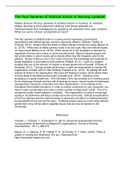The Four Spheres of Political Action in Nursing (graded)
Please discuss the four spheres of political action in nursing. In addition, please develop a brief argument sharing how these spheres are interconnected and overlapping by applying an example from your practice. What are some ethical considerations here?
The four spheres of political action in nursing are the workplace, government, associations and interest groups, and the community ( Mason, Gardner, Outlaw, & O'Grady, 2016). Nurses have the ability to affect change in those four areas (Mason et al., 2016). While each of these spheres exists in its own right, they are interconnected on many levels (Mason et al., 2016). What nurses do in the workplace is directed by regulations that are set in place on governmental levels. Special interest groups and the communities in which nurses serve directly affect how the hospitals care for the patients. Nurses make up one in four voters and have the knowledge and expertise to shape legislation to advocate for their patients (Phillips, 2012). I work at a magnet hospital and one of the tenants of magnet is shared governance (Clavelle, O'Grady, & Drenkard, 2013). Through shared governance, nurses are empowered to change the organization to better care for their patients (Clavelle et al., 2013). By getting the staff actively involved in the organization they have the feeling of control, which allows them to bring ideas to the table and be heard (Clavelle et al., 2013). Smoking in the workplace is a public health risk. The Cleveland Clinic has enacted a no smoking policy
for its employees through working with shared governance, various levels of employees,
management, insurance companies and other organizations. If you belong to the Cleveland Clinic health insurance, in order to receive a discount on your insurance, you have to wear a pedometer and meet a certain number of steps each month. This is to combat the public health epidemic of obesity. The organization is trying to encourage activity in its staff which will help us better serve the community. Ethical considerations of the four spheres and the interconnection is obviously corruption or making decisions for the benefit of one and not the many. If interest groups have too much sway with the government, they will be able to legislate issues that are may be harmful to the community. References
Clavelle, J., O'Grady, T., & Drenkard, K. (2013). Structural empowerment and the nursing practice environment in Magnet (R) organizations. Journal of Nursing Administration, 43(11), 566-573.
Mason, D. J., Gardner, D. B., Outlaw, F. H., & O'Grady, E. T. (Eds). (2016). Policy & politics in nursing and healthcare (7th ed.). Retrieved from https://bookshelf.vitalsource.com Phillips, C. D. (2012). Emergency nursing advocacy: Nurses becoming political advocates. Journal of Emergency Nursing, 38, 470-471. doi:10.1016/j.jen.2012.05.022
ameka,
Thank you for your post! I especially liked your explanation of nurse to patient ratios and how the political climate has influenced this. Should not the institution hire more caregivers if they are making
more money?? Just saying......
Dr. Stiller:
Nurse to patient ratios is another way in which nurses can show their collective legislative power. Campaigning on a patient safety platform, California was able to mandate patient ratios of four patients or less to every one registered nurse depending on the unit acuity (Strachan-Hall,
2017). When this mandate was passed, there was a concern about having enough funding for this number of nurses and being able to recruit the right number, but these fears were not realized
(Strachan-Hall, 2017). Here in Ohio, there is no such mandate. Luckily, I work at a main campus and during the day on my stepdown unit we rarely have greater than a four to one ration, sometimes it is five to one. At night however, it can be five to six to one. The Cleveland Clinic is the number one heart center in the country. We care for the sickest of the sick, and the post-
operative patients we see on my floor are often 24 hours out of open heart surgery. We also care for LVAD and total artificial heart patients. Our patients on stepdown are easily ICU patients in other hospitals. I say this not to brag, but to say it is difficult to recruit, train and maintain experienced nurses. Nurses become overworked and fatigued quickly in this environment. It is difficult to stay motivated when you feel you’re not able to care for your patients thoroughly because you do not have time. This is where nurses should advocate not just for their patients but for themselves as well. If we used the special interest groups and tried to lobby our states for
mandates, perhaps we would have a happier, healthier workforce. California has seen up to a two percent drop in staff sicknesses and a drop in turnover (Strachan-Hall, 2017). This leads to better outcomes for the patients (Strachan-Hall, 2017). While it seems like it would cost the hospitals more to hire additional nurses, it would actually save them money because it would lower turnover and training costs (Strachan-Hall, 2017). It is easier and less expensive to keep the skilled nurses you have than to hire new nurses each year. Reference
Strachan-Hall, E. (2017). California has won case for nurse-patient ratios. Nursing Management - UK, 23(9), 15.




